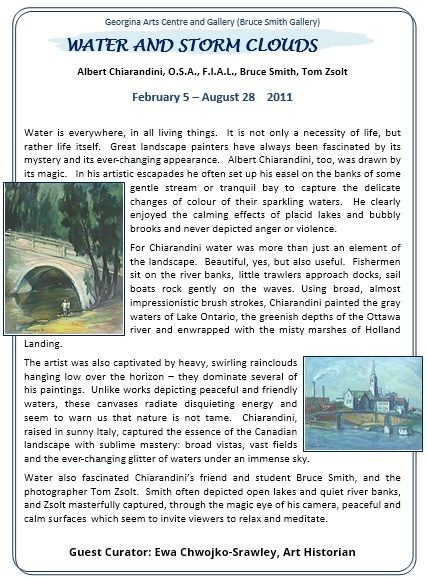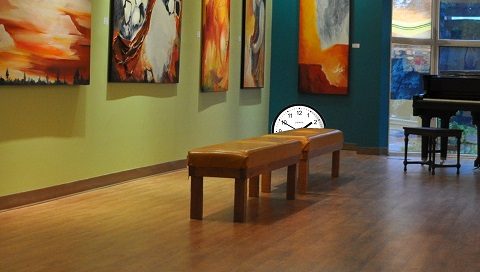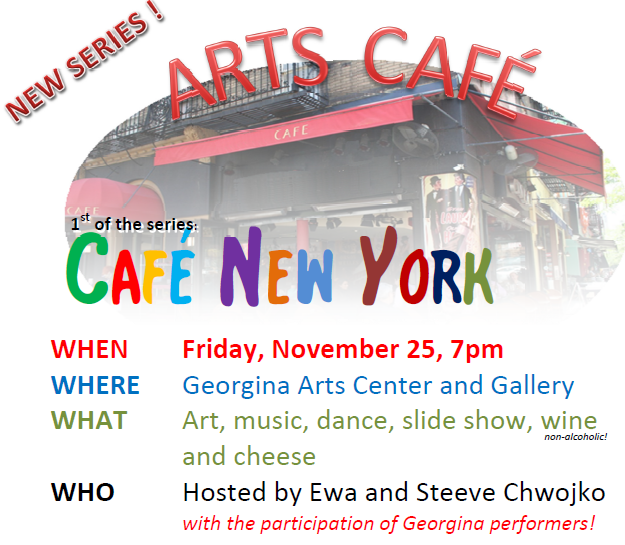
In which we try to understand the days of the week
As guest curator I volunteered to create exhibitions in the Bruce Smith Gallery. I should explain that the Georgina Arts Centre gallery consisted of two sections. There was one rather large room which was the main gallery, and the wide staircase that led to the emergency exit was used as a second gallery where smaller exhibitions could be hung. This was baptised the ‘Bruce Smith Gallery’ in honour of the philanthropist who had donated some two hundred paintings by Albert Chiarandini as well as several of his own, to form the foundation of the Georgina Arts Centre permanent art collection (more on this later). To these were added a number of superb photographs donated by the renowned photographer Tom Zsolt.

One of the first exhibitions I curated was themed ‘Water and Clouds’, and it displayed paintings by Chiarandini and Smith, as well as photographs by Tom Zsolt, from this permanent collection.


At first, we had chosen Monday evenings for our presentations. We assumed that people would be fresh at the beginning of the week, and would like to get out to see a stimulating show. We experimented with a Wednesday evening time slot, but in the middle of the work week people are much less inclined to enjoy themselves. We therefore went back to Monday, and for 2010 and much of 2011 keep with the start of the week. Rembrandt and Van Gogh were our Monday presentations in 2011.

Steeve was so intrigued by the correct, Dutch, pronunciation of ‘Van Gogh’ that he wanted to use it throughout the presentation. I told him that from being often unintelligible he would become completely unintelligible, so he grudgingly agreed to stick with the Canadian pronunciation (for those of you who are interested, it should be pronounced ‘fun who-ch’, ‘ch’ as in the Scottish ‘loch.’)
By the fall of 2011, however, we changed our minds again and decided that what people really wanted was to relax after a week’s work. Friday evening was the obvious choice.
Wrong again…On Fridays, people just want to put their feet up. It was not until 2013 that the best time for presenting was set: Sunday afternoon. It took 2 1/2 years to find that out…
Once we had discovered the existence of Sunday afternoon, we stuck with it through the years. Audiences seemed to enjoy it, perhaps because it offered an alternative to taking the dog for an afternoon walk, and when we expanded into music concerts it turned out that it was also a good time for musicians. The only objection came from our dog, who now missed his walk.

As we became more expert in the art of making computer presentations, they naturally became longer and more elaborate, and we soon realized that we could not keep up a schedule of one show every couple of months; a single computer presentation requires two to three hundred hours of preparation! To give you an idea of the work involved, here are two images, one with a streetlight, and one without:

The problem of course is to create a background, where the image has been removed. This may seem like a small task, but it takes about an hour of careful work, blending colours and removing scars.
There is a very funny story connected with this streetlight. Steeve was convinced that the light ruined the painting, and set out to prove it by removing that part of the image and replacing it with wall and sky. Here is the reaction of the audience when we presented it:
There was also a timing problem that we soon became aware of. We would practice our presentation at home, and make sure that we could get through it in, say, one and a half hours. Then in public, suddenly two and a half hours, or even three, would go by! We therefore got an enormous clock with a 50cm face and placed it discretely on the floor where Steeve could see it, but the audience could not. The idea was that, if we were talking too long, Steeve would say something like “So, let’s move on to the next painting”.

But I could never remember this ‘coded signal’… How often it happened that I said to him “go back! I have more to say.” Steeve would then start making signs at me to move on, signs that I would not notice because I was still talking…
In 2011 we produced three shows, and two or three per year became the norm.
 We continued with the Art Scandals series, adding Rembrandt (scandalous overspending) and Van Gogh (who quarrelled with everyone), but by the fall of 2011 we wanted to be broader in our approach and talk more about an ‘art scene’ rather than a single artist. We decided to start a new series called Arts Café, where we would focus on a city rather than an artist.
We continued with the Art Scandals series, adding Rembrandt (scandalous overspending) and Van Gogh (who quarrelled with everyone), but by the fall of 2011 we wanted to be broader in our approach and talk more about an ‘art scene’ rather than a single artist. We decided to start a new series called Arts Café, where we would focus on a city rather than an artist.
The first in the series was Café New York.
OH! New York! Do we show the audience nice paintings and play them nice music, or do we tell them what really happened?
We decided to steer a mid-course, and ignore the raciest. By the way, that is racy, not race. Here for example is the dance we showed, Buck and Bubbles from the 1920s:
We talked about architecture, social events, geography, inventions…and of course, music. Steeve could play the violin (without demanding a fee!) and so we had a source of live music whenever possible.
But a violin needs a piano… unaccompanied violin music is rare. And so Steeve decided to record the accompaniment and play along with it. Now a new problem arises: a live performance will pull and push on the rhythm (it’s called rubato) whereas an electronic performance is notoriously rigid. The solution is to discretely add to the recording notes that the composer never intended, and listen for them as a guide!
